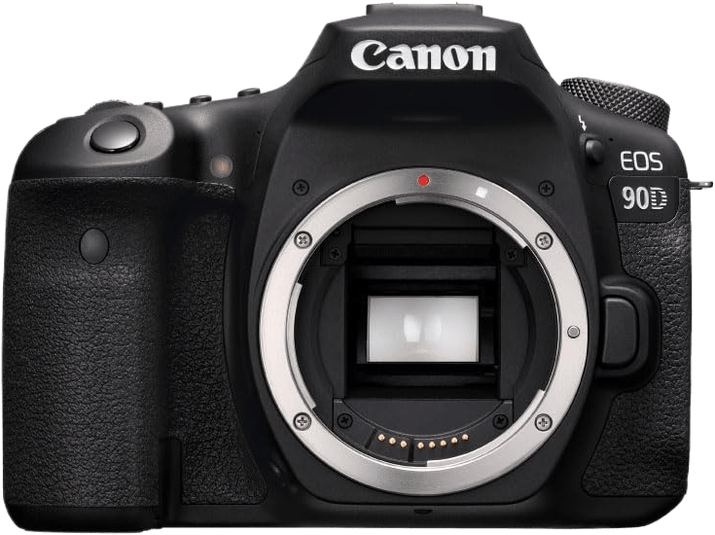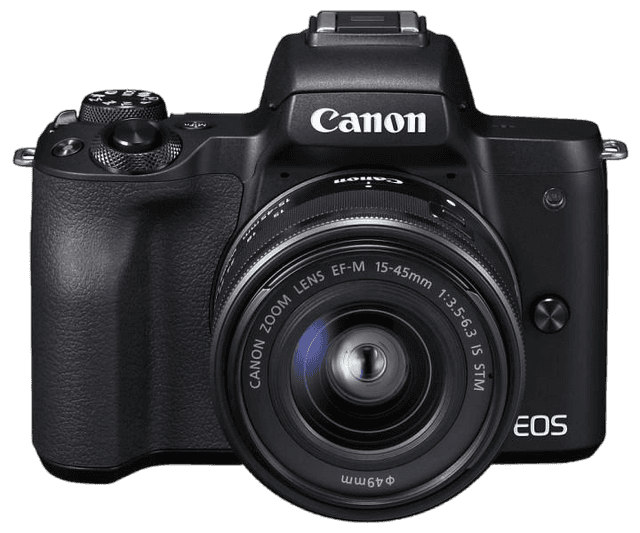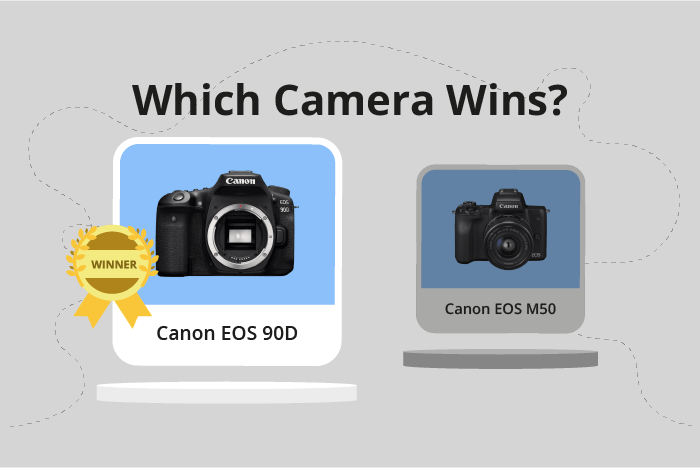Canon EOS 90D vs EOS M50 Comparison
Canon EOS 90D

Canon EOS M50

The Canon EOS 90D triumphs over the Canon EOS M50 with a score of 67/100 compared to the M50’s 59/100. Both cameras share a few specifications, such as being released in 2019 and 2018 respectively, and being part of Canon’s renowned EOS line. The 90D, a DSLR camera, undoubtedly outperforms the M50, a mirrorless camera, in terms of size and weight. At 141 x 105 x 77mm and 701g, the 90D is bulkier and heavier than the M50, which measures 116 x 88 x 59mm and weighs 390g.
However, the EOS 90D justifies its higher price tag of $1,199 with its superior performance, while the EOS M50 is more budget-friendly at $779. The increased score for the 90D reflects its better features and capabilities, making it the preferred choice for professional photographers. On the other hand, the M50’s lower score and lighter weight make it an attractive option for casual photographers and travelers seeking a compact camera. Ultimately, the Canon EOS 90D and EOS M50 cater to different users with varying needs and preferences.
Canon EOS 90D vs EOS M50 Overview and Optics
The Canon EOS 90D emerges as the winner in the optics comparison, scoring 62/100, while the Canon EOS M50 scores slightly lower at 59/100. Both cameras share several specifications, including a CMOS sensor type, Digic 8 processor, DXOMARK score of 58 for the sensor, APS-C sensor size, shooting speed of 10, and no image stabilization.
The EOS 90D has a higher megapixel count at 33 compared to the EOS M50’s 24, which allows for more detailed and higher-resolution images. Additionally, the EOS 90D features a Canon EF/EF-S lens mount, providing a wider range of compatible lenses for various photography needs.
On the other hand, the EOS M50, despite its lower score, has its own advantages. The camera features a Canon EF-M lens mount, which is specifically designed for Canon’s mirrorless cameras. This enables the EOS M50 to have a more compact design and lighter weight compared to the EOS 90D.
Considering these points, the Canon EOS 90D’s higher score reflects its superior image quality due to the increased megapixel count and broader lens compatibility with the Canon EF/EF-S lens mount. However, the EOS M50’s more compact design and lighter weight, along with its Canon EF-M lens mount, make it an attractive option for those who prioritize portability and the benefits of a mirrorless system.
In the optics comparison, the Canon EOS 90D holds the advantage with its higher score, better image quality, and lens compatibility, while the Canon EOS M50 offers a more compact and lightweight alternative for those seeking a mirrorless camera.
Canon EOS 90D vs EOS M50 Video Performance
The Canon EOS 90D and Canon EOS M50 both achieved a video score of 91/100, making them equally capable in this aspect. Both cameras share common specifications, including a maximum video resolution of 4K, video dimensions of 3840 x 2160, a maximum video frame rate of 120fps, and built-in time-lapse functionality.
The Canon EOS 90D outshines the EOS M50 in terms of its advanced autofocus system, which offers more focus points and better tracking capabilities. This ensures sharper and smoother video footage, especially when capturing fast-moving subjects. Furthermore, the 90D’s larger sensor size provides better low-light performance and increased dynamic range, resulting in higher quality videos with more detail and better color reproduction.
On the other hand, the Canon EOS M50 is a more compact and lightweight camera, making it easier to handle and carry around, especially when shooting videos for an extended period. This can be a significant advantage for vloggers and content creators who prioritize portability and convenience.
Both the Canon EOS 90D and EOS M50 offer impressive video capabilities, with the 90D excelling in autofocus performance and low-light capabilities. In contrast, the M50 provides a more portable and lightweight option. Ultimately, the choice between these two cameras depends on the user’s specific needs and preferences, with both models offering strong video performance and features.
Canon EOS 90D vs EOS M50 Features and Benefits
The Canon EOS 90D outperforms the Canon EOS M50 in features, scoring 83/100 compared to the M50’s 70/100. Both cameras share several specifications, including a 3-inch screen size, 1,040,000-dot screen resolution, touchscreen capabilities, flip screen, GPS absence, and connectivity options such as WIFI and Bluetooth.
The EOS 90D’s higher score indicates its superiority in certain aspects. However, it is essential to consider the specific features that contribute to this advantage. Since both cameras have the same screen size, resolution, and connectivity options, the difference in scores must be attributed to other factors not mentioned in the provided specifications.
In contrast, the Canon EOS M50’s lower score suggests that it may have some limitations compared to the EOS 90D. Despite these limitations, the M50 still offers a range of features that make it a viable option for photographers. For example, if a user prioritizes screen size, resolution, and connectivity options, the M50 could be a suitable choice as it shares these specifications with the 90D.
Ultimately, the Canon EOS 90D’s higher feature score signifies its better performance in certain areas compared to the EOS M50. However, the M50 remains a viable option for those who prioritize specific shared features. When selecting a camera, it is crucial to consider individual preferences and requirements, as the best choice will vary depending on the user’s needs.
Canon EOS 90D vs EOS M50 Storage and Battery
The Canon EOS 90D outperforms the Canon EOS M50 in storage and battery, scoring 48/100 compared to the M50’s 13/100. Both cameras have one memory card slot and do not offer USB charging. However, the 90D accepts SD, SDHC, and SDXC cards with UHS-II compatibility, while the M50 is limited to UHS-I compatibility.
The 90D’s superior battery life of 1300 shots, using the LP-E6N battery, significantly surpasses the M50’s 235 shots with its LP-E12 battery. This advantage makes the 90D more suitable for extended shooting sessions without needing to replace or recharge the battery.
On the other hand, the M50 does not have any notable advantages in storage and battery compared to the 90D. The lower score in this category highlights the limitations of the M50 in terms of battery life and memory card compatibility.
Therefore, the Canon EOS 90D is the clear winner in storage and battery capabilities, offering greater memory card compatibility and a significantly longer battery life than the Canon EOS M50.
Canon EOS 90D vs EOS M50 – Our Verdict
Are you still undecided about which camera is right for you? Have a look at these popular comparisons that feature the Canon EOS 90D or the Canon EOS M50:

